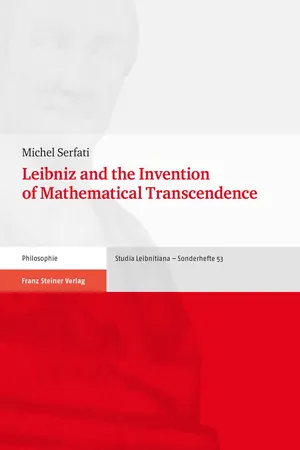
- 250 pages
- English
- PDF
- Available on iOS & Android
Leibniz and the Invention of Mathematical Transcendence
About this book
The invention of mathematical transcendence in the seventeenth century is linked to Leibniz, who always claimed it to be his own creation. However, Descartes had created a completely new symbolic frame in which one considers plane curves, which was a real upheaval. Leibniz initially appreciated this Cartesian frame. Although, as we see in the e-book, during his research he was confronted with inexpressible contexts he then called 'transcendent'.
The development of a concept of mathematical transcendence is at the core of this e-book. The description follows a pragmatic path by highlighting how and why aspects of the concept were developed and which obstacles were encountered by mathematicians. Also, there were some dead ends which are described here. Leibniz exceeded Descartes' ideas on a symbolical level (transcendent expressions), a geometrical level (transcendent curves) as well as a numerical level (transcendent numbers) those are also examined in detail.
Frequently asked questions
- Essential is ideal for learners and professionals who enjoy exploring a wide range of subjects. Access the Essential Library with 800,000+ trusted titles and best-sellers across business, personal growth, and the humanities. Includes unlimited reading time and Standard Read Aloud voice.
- Complete: Perfect for advanced learners and researchers needing full, unrestricted access. Unlock 1.4M+ books across hundreds of subjects, including academic and specialized titles. The Complete Plan also includes advanced features like Premium Read Aloud and Research Assistant.
Please note we cannot support devices running on iOS 13 and Android 7 or earlier. Learn more about using the app.
Information
Table of contents
- TABLE OF CONTENTS
- LEIBNIZ AND THE INVENTION OF MATHEMATICAL TRANSCENDENCE. THE ADVENTURES OF AN IMPOSSIBLE INVENTORY
- FIRST PART. DISCOVERING TRANSCENDENCE
- SECOND PART. THE SEARCH FOR AN INVENTORY
- THIRD PART. TOWARDS AN “ANALYSIS OF THE TRANSCENDENT”
- FOURTH PART. THE RECEPTION OF THE TRANSCENDENCE
- REFERENCES